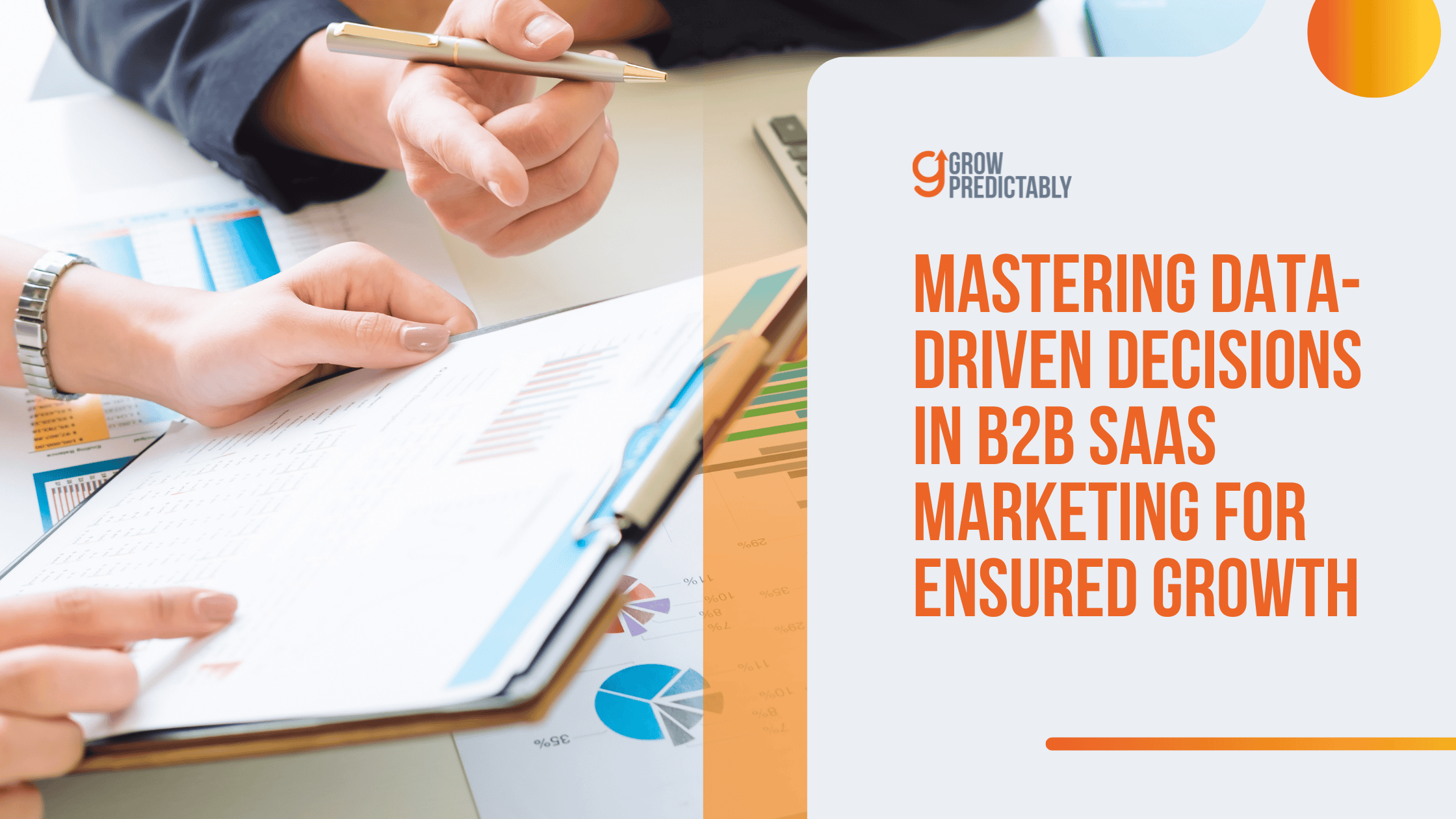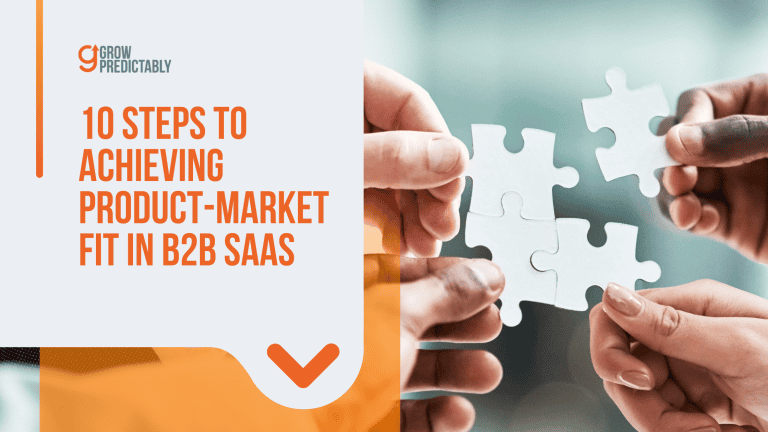Mastering Data-Driven Decisions in B2B SaaS Marketing for Ensured Growth
Check this out – companies that base their business decision on data analytics see 63% more productivity than those that don’t. (Business.com)
Not making this up.
I’ve seen it firsthand, working with dozens of B2B SaaS companies.
But here’s the thing – most folks are doing it wrong.
Today, let’s tackle the different steps you’ll need to take to make sound data-driven decisions in B2B SaaS marketing for growth!
How is Data Linked to Business Growth?
A data driven marketing strategy is the backbone of growth in both marketing and business.
It provides clarity, helping you understand what’s working and what isn’t.
When you base decisions on data, you’re not guessing—you’re acting on real insights.
For B2B marketing professionals, data driven marketing reveals how your marketing campaigns are performing, where your leads are coming from, and what resonates with your audience.
Instead of wasting resources on marketing strategies that might not work, you can double down on efforts that deliver results.
Metrics like customer acquisition cost (CAC), customer lifetime value (LTV), and conversion rates help you fine-tune your approach, improving ROI.
This is echoed by what the former Freshbooks CMO said…
Tracking marketing is a cultural thing. Either tracking matters or it doesn’t. You’re in one camp or the other. Either you’re analytical and data-driven, or you go by what you think works. People who go by gut are wrong.
Stuart McDonald, Consultant & Former Freshbooks CMO
For SaaS business owners, data offers visibility into customer behavior through customer data and business performance through analytics.
It shows you which features drive engagement, where users drop off, and how to boost retention.
This kind of insight, when combined with customer feedback, allows you to make smarter product decisions and scale effectively.
Digital marketing agencies also thrive on data. It’s what helps them demonstrate value to clients, optimize marketing campaigns, and stay competitive in a crowded marketplace.
In short, data driven marketing drives growth because it takes the guesswork out of decision-making.
It empowers you to act with precision, reduce risk, and achieve measurable, repeatable success.
Without it, you’re navigating blind. So, treat data as non-negotiable in your decision-making process.
To get started, here’s one tool that can help you do just that.
How the Growth Scorecard Champions Data Use
If you’re looking for a practical way to become more data-driven in your B2B marketing, the Growth Scorecard is your go-to tool.
It’s designed to track key performance indicators (KPIs) across every stage of your customer journey, helping you make decisions backed by actionable insights.
The Growth Scorecard stands out because it simplifies the overwhelming task of data tracking.
Instead of swimming in irrelevant metrics, it keeps your focus on what truly matters—metrics tied directly to your goals.
For B2B marketers, this means understanding where your leads are coming from, how they convert, and what keeps them engaged.
Why the Growth Scorecard Matters
In B2B marketing, decisions need to be grounded in data, not gut feelings.
The Growth Scorecard helps you move beyond vanity metrics, like total website visits, to actionable insights tied to a data driven marketing strategy that impacts revenue and growth.
With a clear view of your metrics, you’ll know where to optimize and where to pivot, saving time and resources while improving outcomes.
PRO TIP: Track your marketing data on a weekly basis using the growth scorecard to keep data in check regularly, especially whenever you have to make changes to your B2B marketing efforts.
Why Weekly Tracking Matters
Weekly tracking isn’t just a suggestion—it’s a best practice.
The SaaS world moves fast, and waiting for monthly reports could mean catching problems too late.
Weekly updates let you spot trends early, fix issues quickly, and make timely adjustments to your marketing efforts.
It keeps you agile, which is essential in a competitive market.
How to Implement the Growth Scorecard
Here’s a simple example of how you can use the Growth Scorecard in your B2B marketing strategies: Imagine you’re running a campaign to drive demo sign-ups.
At the “Aware” stage, your scorecard tracks metrics like the number of qualified visitors and their source (e.g., LinkedIn, organic search).
Let’s say your data reveals that while LinkedIn drives 300 visitors, organic search brings only 100.
However, organic search generates more demo sign-ups.
With this insight, you’d allocate more resources to optimizing your marketing strategy.
Then, track the next stage—how many demos lead to paid sign-ups—and refine further.
Each week, you’d update your Growth Scorecard to stay on top of these trends, adjusting your tactics as needed.
A Tool That Drives Smart Decisions
By breaking down the customer journey into clear, measurable stages, the Growth Scorecard helps you avoid guesswork and focus on real growth drivers.
It’s not just a tracking tool; it’s a decision-making powerhouse.
Commit to tracking the right metrics weekly, and let the Growth Scorecard guide your way to smarter, faster, and more profitable marketing decisions.
Aside from this tool, what else can you do to allow data to drive your decisions?
Here are some practices to start implementing in your B2B SaaS.
5 Ways to Become a Data-Driven Decision Maker in B2B SaaS

Becoming a data-driven decision-maker isn’t just about collecting numbers—it’s about using them to fuel growth.
Here are five practical steps to help you harness the power of data and naturally drive B2B SaaS growth.
1. Define Clear Goals and Align Metrics to Them
You can’t measure what you don’t define.
Start by setting clear, measurable goals for your B2B SaaS business.
These could include:
- Increasing trial-to-paid conversion rates
- Reducing churn
- Boosting average revenue per user (ARPU)
Without specific goals and leveraging customer data, you’re likely to track vanity metrics—numbers that look good but don’t contribute to growth.
Defining goals helps ensure you focus only on data that impacts your bottom line.
Let’s break it down with an example.
Step 1: Start with a Business Objective
Imagine your SaaS company offers a project management tool, and your goal is to increase trial-to-paid conversion rates.
This is a specific, measurable objective that ties directly to revenue growth.
Step 2: Identify the Right Metrics
To measure your progress toward this goal, focus on metrics that give actionable insights. For trial-to-paid conversion, this might include:
- Trial Signup Source: Which channels (e.g., paid ads, organic search, referrals) are driving the most qualified signups?
- Feature Engagement: What percentage of trial users engage with key features during the trial period?
- Onboarding Completion Rate: How many trial users complete onboarding steps within the first week?
These metrics help you pinpoint where users are falling off and which touchpoints need improvement.
Step 3: Track Metrics Consistently
Set up dashboards to track these metrics weekly.
Use tools like Mixpanel, Google Analytics, or other leading predictive analytics software to automate data collection and visualization..
For example, if onboarding completion rates are low, your dashboard should highlight this for immediate action.
Step 4: Translate Data into Actionable Steps
Suppose your data reveals that only 40% of trial users complete onboarding, and those who don’t convert are 50% less likely to upgrade.
This insight tells you that improving onboarding could significantly impact your conversion rates.
Here’s what you might do:
- Create a guided walkthrough for new users to showcase key features enhancing customer satisfaction.
- Send personalized follow-up emails to users who don’t complete onboarding within three days.
- Offer a webinar to address common questions during the trial period.
Step 5: Evaluate and Refine
After implementing changes, keep tracking your metrics.
Did the onboarding improvements increase the trial-to-paid conversion rate?
If not, dig deeper—maybe it’s time to revisit your trial’s feature limitations or pricing clarity.
2. Set Up a Reliable Data Tracking System
A good system makes all the difference. This includes tools like Google Analytics, CRM software, or a dedicated platform like HubSpot or Mixpanel.
Choose tools that integrate seamlessly with your existing workflows.
Without accurate and reliable data, you’re making decisions in the dark.
The right tools, including predictive analytics platforms, ensure you collect the customer data you need without the risk of errors or gaps.
WHAT YOU CAN DO NOW: Audit your current tools to see if they’re capturing essential data. If not, invest in software that tracks your customer journey end-to-end. Ensure all team members are trained to use the tools effectively.
To find the best data tracking system for your needs, follow this:
- Define Your Needs: Identify the key metrics and data points your business needs to track, like user behavior, conversions, or customer retention.
- Ensure Compatibility: Choose tools that integrate easily with your existing platforms, such as your CRM or email marketing software, to streamline workflows.
- Prioritize Usability: Opt for tools with intuitive interfaces and customizable dashboards to make data easy for your team to access and understand.
- Check Scalability: Select a solution that can grow with your business, handling more data and complexity as your SaaS company scales.
- Evaluate Support and Training: Look for tools that offer strong customer support and training resources to ensure smooth implementation and ongoing use.
3. Make Weekly Data Reviews a Habit
Don’t wait until the end of the quarter to look at your numbers.
Weekly reviews keep you informed and allow for quick course corrections.
In SaaS, things change fast. A sudden spike in churn or a dip in conversions can quickly escalate without agile marketing strategies in place.
Regular reviews help you catch issues early.
Schedule a weekly data review meeting to ensure your marketing efforts stay aligned with business goals.
Use a shared dashboard like a Growth Scorecard to track key metrics.
Keep the meeting focused—identify trends, flag concerns, and assign next steps.
4. Focus on Actionable Insights, Not Just Data Collection
Having data is useless if you don’t act on it.
The real value comes when you use insights to optimize marketing campaigns, improve products, and refine customer experiences for your target audience.
Too many businesses fall into “analysis paralysis,” overwhelmed by endless numbers without clear action steps.
Insights, paired with customer feedback, drive meaningful change in your marketing strategies.
For each metric you track, always ask, “What does this mean for our marketing strategy?”
Develop an action plan based on the trends you observe.
For instance, if your demo-to-paid conversion rate is low, revisit your demo process to make it more engaging or clear.
5. Foster a Data-Driven Culture Across Teams
Being data-driven isn’t just the responsibility of your marketing or analytics team—it’s crucial for improving customer satisfaction.
Every department, especially sales and marketing teams, should leverage data to make decisions.
A unified approach ensures consistency among sales and marketing teams.
When every team aligns their efforts with shared data insights, you avoid silos and improve overall efficiency.
Adopting a data-driven culture across teams is crucial for B2B businesses to operate cohesively and avoid silos.
Here’s a five-step guide to help you implement this approach:
1. Align on Shared Goals
Every team must understand the overarching business objectives and how their efforts contribute.
- Hold cross-departmental meetings to establish shared KPIs, like customer acquisition cost (CAC) or churn rate, that everyone tracks.
- Ensure individual teams have metrics aligned to these shared goals to create a unified direction.
TIP: Use a shared dashboard tool (e.g., Tableau, Power BI) to provide visibility into progress for all teams.
2. Foster Cross-Team Collaboration
Encourage departments like sales, marketing, and customer success to work together on sharing customer data initiatives that enhance customer satisfaction.
- Create joint projects where data is pooled to solve shared challenges and better address your target audience, like improving lead quality or retention.
- Schedule regular meetings to discuss insights and align marketing strategies.
TIP: Use collaboration tools like Slack or Microsoft Teams to create data-focused channels for ongoing discussions.
3. Standardize Data Collection and Reporting
Set up a consistent system for data tracking across all teams.
- Ensure everyone uses the same tools and methodologies to collect and analyze data, reducing discrepancies.
- Create a centralized repository for all key metrics, accessible to relevant stakeholders.
4. Promote Data Literacy
Provide training to ensure all teams understand how to interpret and act on data.
- Offer workshops or online courses on analyzing reports, understanding KPIs, and identifying trends.
- Make data literacy a key part of onboarding for new employees.
Encourage cross-departmental collaboration between sales and marketing teams by sharing dashboards and reports regularly.
Provide training sessions to help all teams understand how to interpret and act on data.
Recognize and reward data-driven behaviors to embed this mindset in your company culture.
By implementing these five steps, you’ll not only become a more data-driven decision-maker but also create a foundation for sustainable B2B SaaS growth.
Start small, build consistency, and watch the results unfold.
More importantly, start in the right areas—specifically in these four crucial areas in your B2B marketing.
4 Areas in B2B Marketing Where It’s Important to Be Data-Driven
Trusting your gut isn’t enough when it comes to B2B marketing—you need numbers to guide you.
By focusing on key areas like audience segmentation, content marketing, channel optimization, and competitor analysis, you can create smarter campaigns that truly connect with your audience.
Let’s break down how leveraging data in these areas can take your marketing efforts to the next level.
1. Audience Segmentation
Understanding your audience deeply is the foundation of effective marketing.
Data-driven segmentation allows you to create targeted campaigns, personalize messaging, and address specific customer pain points.
Without clear segmentation, your efforts risk being too broad and inefficient.

Here’s how data can be leveraged in audience segmentation:
- Analyze website behavior to identify high-intent visitors.
- Group prospects by industry, company size, or location.
- Use CRM data to categorize leads based on lifecycle stages.
Imagine a B2B SaaS company launching a project management tool.
Using data from their CRM and website analytics, they identify three key segments: small businesses seeking affordability, mid-sized firms prioritizing collaboration features, and enterprises requiring scalability.
With these insights, the company tailors messaging and offers for each segment.
For small businesses, they highlight cost savings; for mid-sized firms, collaboration tools; and for enterprises, advanced integrations.
This targeted approach leads to higher engagement and conversion rates.
2. Content Marketing
Content marketing drives awareness, builds trust, and nurtures leads.
Leveraging data ensures your content addresses actual audience needs, stands out, and delivers measurable ROI.
Data-driven content also prevents wasted efforts on irrelevant topics.
Here are examples of how data is used in content marketing:
- Identify trending topics using keyword research tools.
- Track engagement metrics to refine underperforming content.
- Analyze FAQs to uncover audience pain points.
Let’s say a cybersecurity firm uses keyword research tools to discover that “cloud data protection strategies” are a high-demand topic.
They create an in-depth guide addressing specific concerns about cloud security.
Analytics reveal that long-form blog posts attract higher engagement, so the guide includes case studies and expert quotes.
By tracking user feedback and time-on-page metrics, they refine their content to increase engagement further, helping capture more leads through gated content and stronger positioning as an industry authority.
3. Optimizing Your Marketing Channels
With multiple marketing channels available, choosing where to focus can be overwhelming.
Data-driven optimization allows you to prioritize channels that deliver the best ROI, reach your target audience effectively, and allocate resources efficiently.

Here’s how data helps optimize marketing channels:
- Track conversion rates for paid campaigns across channels.
- Use A/B testing to refine email subject lines.
- Monitor social media engagement to identify top-performing platforms.
For example, a B2B logistics company evaluates its marketing channels and finds that LinkedIn drives significantly higher conversions than Twitter or Facebook.
They reallocate ad spend to LinkedIn and use A/B testing to optimize sponsored content.
Additionally, they identify that emails with industry insights achieve higher open rates, prompting them to adjust email strategies accordingly.
By continually analyzing channel performance, the company can better work toward maximizing ROI and attracting more qualified leads.
4. Competitor Analysis
Understanding your competitors helps you identify market opportunities, refine your positioning, and stay ahead.
Data-driven competitor analysis uncovers gaps in their offerings, marketing strategies, and customer engagement efforts, giving you a strategic advantage.
Here are examples of how data enhances competitor analysis:
- Use SEO tools to find competitors’ top-performing keywords.
- Track their social media activity to gauge audience response.
- Monitor their pricing models to identify differentiation opportunities.
Imagine a B2B fintech startup using SEO tools to analyze a leading competitor’s website.
They discover that the competitor ranks highly for “small business loan automation.”
By examining customer reviews, they find complaints about the competitor’s customer service.
The startup creates marketing content emphasizing their superior support and targets the same keyword with optimized blog posts and paid ads.
This approach to leveraging data can help them attract dissatisfied customers and establish themselves as a credible alternative.
Now, let’s take a look at how other brands are putting this into practice.
OMNIUS’ Data-Driven Approach to SaaS Growth Through Topic Clustering

In this case study, OMNIUS collaborated with a SaaS AI writing tool to enhance its organic traffic, which was initially around 20 daily visits, with 193 keywords ranked and none in the top 3 positions.
Problem: The primary challenges identified were:
- Inexperienced Writers: Hiring writers lacking industry experience led to low-quality content, diminishing customer trust.
- Absence of Standardized Procedures: Without a cohesive SEO strategy, content lacked synergy, hindering niche dominance on Google.
- Insufficient Research: Content suffered from inadequate research, resulting in generic articles that failed to engage readers.
Solution: OMNIUS implemented a data-driven SEO strategy centered on content clustering.
- Content Clustering: Developed interconnected articles around core topics to enhance topical authority and improve search engine rankings.
- Quality Assurance: Established procedures to standardize content quality, ensuring each piece met SEO and reader engagement standards.
- Comprehensive Research: Emphasized detailed research to produce high-value content that addressed user intent and needs.
Implementation: The marketing strategy involved:
- Topic Identification: Conducted data analysis to identify high-potential topics relevant to the target audience.
- Content Creation: Produced a series of articles forming clusters around these topics, ensuring internal linking for better SEO performance.
- Regular Publishing: Maintained a consistent publishing schedule to signal to search engines the site’s ongoing relevance and authority.
- Performance Monitoring: Utilized analytics tools to track metrics such as organic traffic, keyword rankings, and user engagement, allowing for data-driven adjustments.
Results: Within seven months, the SaaS AI tool achieved:
- Over 1,000 unique daily organic visits.
- More than 60,000 monthly organic search visits.
- Ranking for 22,500+ organic keywords, with 1,000+ on the first page and 200 in the top 3 positions.

Data-Driven Approach: OMNIUS’s success stemmed from leveraging data at each step:
- Data Analysis: Informed topic selection and content clustering strategies.
- Performance Metrics: Monitored key indicators to guide ongoing optimization efforts.
- Continuous Improvement: Relied on data insights to refine content quality and SEO tactics, ensuring sustained growth.
This methodical, data-centric approach was instrumental in transforming the client’s online presence and significantly boosting organic traffic.
However, to make any data-driven approach to marketing work you shouldnt just focus on your methods.
Every brand must know what to avoid, too.
3 Common Hurdles When Transitioning to a More Data-Driven Approach

Those success stories sound great, right?
But let’s get real – even the companies crushing it had to deal with some major headaches first.
Here are the actual problems B2B SaaS companies run into, and how to fix them.
1. Your Data’s All Over the Place
You’ve got numbers in Salesforce, metrics in Google Analytics, and spreadsheets everywhere.
Your sales team uses one system, marketing another, and support’s doing their own thing.
It’s a mess.
Why it’s annoying: Your reports don’t match up.
Sales says one thing, marketing another.
You waste hours trying to figure out which numbers are right.
Making decisions becomes a nightmare.
The fix: Start with a data map.
List every place your data lives.
Then pick ONE source of truth for each metric.
2. Too Much Data, Not Enough Action
You’re drowning in dashboards and spreadsheets but can’t figure out what actually matters.
Why it’s annoying: You spend more time making reports than using them.
Your team gets overwhelmed and ignores the data completely.
The fix: Pick your “North Star” metric – the ONE number that matters most.
Then add 2-3 supporting metrics that drive it.
Stripe focuses purely on processing volume as their North Star, with activation rate and churn as supporters.
Everything else is noise.
3. Your Tools Don’t Play Nice Together
You bought five different tools but they won’t connect properly.
Why it’s annoying: You have to manually copy data between systems.
Information gets outdated.
Things break randomly.
The fix: Map out your “minimum viable stack” – the fewest tools you need to get good data.
HubSpot started with just three core tools: their CRM, Google Analytics, and a BI tool.
They only added more once they maxed out what those could do…
Talking about this and all that B2B brands must avoid is a best practice that every B2B expert knows, but even experts need their tools.
Here are some of the marketing tools that are a must in adapting a more data-driven approach to B2B marketing.
REMEMBER: Not all tools serve the same purpose. Choose according to your needs.
Tools and Technologies
The right tools can make or break your marketing efforts.
After dealing with those pesky challenges we talked about earlier, you’ll need the right tech stack to make things work.
Let me break down the main players and help you pick what’s right for your company.
Analytics Tools – The Foundation
Google Analytics 4 vs Adobe Analytics
GA4 is free and works great for most companies – especially if you’re just starting out.
Adobe Analytics costs more (like, way more) but gives you deeper insights if you’ve got complex tracking needs.
Here’s what to know:
GA4
- Free (huge plus)
- Good enough for 90% of B2B SaaS companies
- Built-in machine learning for predictions
- Takes time to learn the new interface (it’s different from Universal Analytics)
Adobe Analytics
- Better for companies with $50M+ revenue
- Superior segmentation options
- More flexible reporting
- Needs a dedicated analyst team
Heat Mapping & User Behavior
These insights can refine your marketing strategies as you see how people actually use your site.
These tools help:
Hotjar vs Mouseflow
- Hotjar: Better for smaller teams, easier to use
- Mouseflow: More features but steeper learning curve
- Both show recordings, heatmaps, and form analytics
- Price: Hotjar starts free, Mouseflow at $24/month
CRM Integration Tools
HubSpot vs Salesforce Marketing Cloud
HubSpot’s marketing hub integrates perfectly with their CRM.
If you’re already using HubSpot’s CRM, this is probably your best bet.
But Salesforce Marketing Cloud is more powerful if you need advanced automation.
HubSpot
- All-in-one platform
- Better UI/UX
- Starts at $800/month
- Great for teams of 2-20
Salesforce
- More customizable
- Better for enterprise
- Complex pricing
- Better for teams of 20+
Email & Communication Analytics
Customer.io vs Intercom
- Customer.io: Better for complex email flows
- Intercom: Better for chat + email combo
- Both offer A/B testing
- Both integrate with most major tools
Choosing The Right Stack
Pick based on:
- Your team size
- Budget
- Technical expertise
- Current tools you’re using
Pro tip: Start small.
Get good with one tool before adding more.
I’ve seen too many companies buy everything at once and end up using nothing well.
Tool Integration Tips
Most important rule: Make sure your tools talk to each other.
Here’s what I mean:
- Your analytics should feed into your CRM
- Your CRM should trigger marketing automation
- Your email tool should sync with everything
I could tell you about 50 more tools, but these cover the basics really well.
The tech world keeps changing fast – next month we’ll probably see new AI tools that make all of this easier.
But for now, these are your best bets.
Remember: Tools are just tools. Their effectiveness depends on integrating them into your marketing strategies.
They won’t fix bad marketing.
But good marketing + the right tools?
That’s when things get interesting.
Speaking of interesting… wait till you see what’s coming next in marketing tech.
AI is about to change everything – but that’s a story for our next section.
FAQs
Key Takeaways
The companies that are gonna crush it in the next few years aren’t the ones with the biggest budgets.
They’re the ones who start preparing now.
And look, I know this might feel overwhelming.
But remember those tools we talked about earlier?
They’re gonna evolve to make all this easier.
The key is starting now, even if it’s just baby steps.
Next up, we’ll wrap this all up and give you a clear plan to actually do something with all this info.
Because knowing about trends is cool and all, but actually using them to grow your business?
That’s what matters.








